
Dɛn Ne Opal Kɔla a Ɛtaa Yɛ Sen Biara? Hwehwɛ mu wɔ Akwankyerɛ yi mu!
 Hwɛ opal biara pɛnkoro na wubehu wiase a kɔla ahorow a ɛhyerɛn fi aboɔden abo no mu. Opals agye din wɔ ade bi a ɛma wotumi hu ade a wɔfrɛ no “play-of-color,” a ɛkyerɛkyerɛ ɔkwan a kɔla fa so saw wɔ ɔbo no so no ho. Opal bo biara nni hɔ a ɛda kɔla biako pɛ adi, enti dɛn ne opal a wɔtaa de di dwuma? Sɛ yɛbɛbua saa asɛm no a, ɛsɛ sɛ yɛhwɛ aboɔden aboɔ no nipadua kɔla (nipadua nne). Sɛ wogyina nipadua no nne so a, opal fitaa ne opal kɔla a abu so sen biara , na opal a ɛyɛ fitaa ne opal a ɛyɛ ahabammono di akyi.
Hwɛ opal biara pɛnkoro na wubehu wiase a kɔla ahorow a ɛhyerɛn fi aboɔden abo no mu. Opals agye din wɔ ade bi a ɛma wotumi hu ade a wɔfrɛ no “play-of-color,” a ɛkyerɛkyerɛ ɔkwan a kɔla fa so saw wɔ ɔbo no so no ho. Opal bo biara nni hɔ a ɛda kɔla biako pɛ adi, enti dɛn ne opal a wɔtaa de di dwuma? Sɛ yɛbɛbua saa asɛm no a, ɛsɛ sɛ yɛhwɛ aboɔden aboɔ no nipadua kɔla (nipadua nne). Sɛ wogyina nipadua no nne so a, opal fitaa ne opal kɔla a abu so sen biara , na opal a ɛyɛ fitaa ne opal a ɛyɛ ahabammono di akyi.
Sɛ wote “nea ɛtaa ba” na wususuw sɛ “ɛyɛ mpapahwekwa” a, yɛbɛpɛ sɛ yɛka kyerɛ wo sɛ susuw ho bio! Wubetumi afrɛ saa aboɔden abo yi sɛ owura a ɔde ne ho hyɛ mu ma opal kɔla ahorow a ɛwɔ hɔ no. Opal ntumi nsie nanso; akyinnye biara nni ho sɛ ne hyerɛn ne kɔla a ɛyɛ nwonwa a wɔde di agoru no bɛtwetwe obiara ani!
Sɛ yɛreka aniwa ho asɛm a, opal nkyerɛase ho nkyerɛkyerɛ biako fi Hela asɛmfua a ɛkyerɛ aniwa, ophthalmos . Fibea foforo a ebetumi aba ne Sanskrit asɛmfua Uppal , a ɛkyerɛ “nufusu bo a ɛsom bo.”
Ebia October nkokoaa behu opal fɛfɛ a ɛte sɛ nufusu no sɛ October awobo a wɔde di dwuma wɔ amanne kwan so no. Sɛ wɔwoo wo wɔ April mu a, wubetumi de w’ankasa opal agude fɛfɛ bi ahyɛ tete ahintasɛm awo abo no anuonyam.
Ɛmfa ho nea ɔde hoahoa ne ho no, opal yɛ aboɔden abo a ɛyɛ nwonwa a ɛyɛ fɛ pii. Sɛ yɛbɛte opal kɔla a abu so sen biara ase yiye a, ɛho behia sɛ yɛde yɛn ho hyɛ opal ahorow no mu ne baabi a efi.
Nea edi kan no, ma yɛnhwɛ nneɛma atitiriw no so.

Dɛn ne Opal Abo?
Opal yɛ mineraloid a silicon dioxide ne nsu dodow a ɛsonosonoe na ɛwom. Nea ɛnte sɛ aboɔden abo dodow no ara no, opal nni ahwehwɛ nhyehyɛe anaa nnuru a ɛkɔ so daa, na ɛma ɛyɛ nea enni nsɛ.
Opal yɛ n’ankasa aboɔden abo abusua, opal abusua no dea. Opal aboɔden abo nya wɔn aguadi agyiraehyɛde a ɛte sɛ ahwehwɛ fi wɔn mu nhyehyɛe a wɔde kurukuruwa a wɔahyɛ no ma denneennen a ɛpaapae hann no mu kɔla ahorow pii na ɛyɛ no mu.
Enti, kɔla bɛn na ɛyɛ opal?
Ebia wode opal bɛbata kɔla ahorow a ɛyɛ hyew a ɛma wokae nyankontɔn a ɛwɔ samina a ɛyɛ mmerɛw so no ho. Nanso, iridescence yɛ opal a ɛsom bo pɔtee.
Opal a ɛsom bo, anaa opal a ɛyɛ anuonyam, yɛ ahorow ahorow a ɛda kɔla ahorow a wɔde di agoru adi. Ɔkwan foforo so no, sɛ wodan ɔbo no wɔ hann no ase a, ɛbɛma aboɔden abo no ahyerɛn wɔ kɔla ahorow mu. Kɔla ahorow no bɛsesa agyina baabi a wobɛhwɛ aboɔden abo no so.
Opal kɔla ahorow a ɛsom bo gu ahorow wɔ abo biara mu. Ebia opal abo a ɛsom bo bi wɔ nnyinaso tuntum te sɛ tuntum anaa ahemfo bruu. Afoforo nso betumi anya nipadua a ɛyɛ fitaa. Opal ahorow bi a ɛsom bo da kɔla ahorow pii adi, kɔla a ɛwɔ ase no yɛ nea wontumi nhu.
Mpɛn pii no, opal a ɛsom bo no yɛ basaa wɔ nea wɔfrɛ no “opal a wɔtaa de di dwuma” ho, a yɛbɛhwehwɛ mu kɔ akyiri bio.
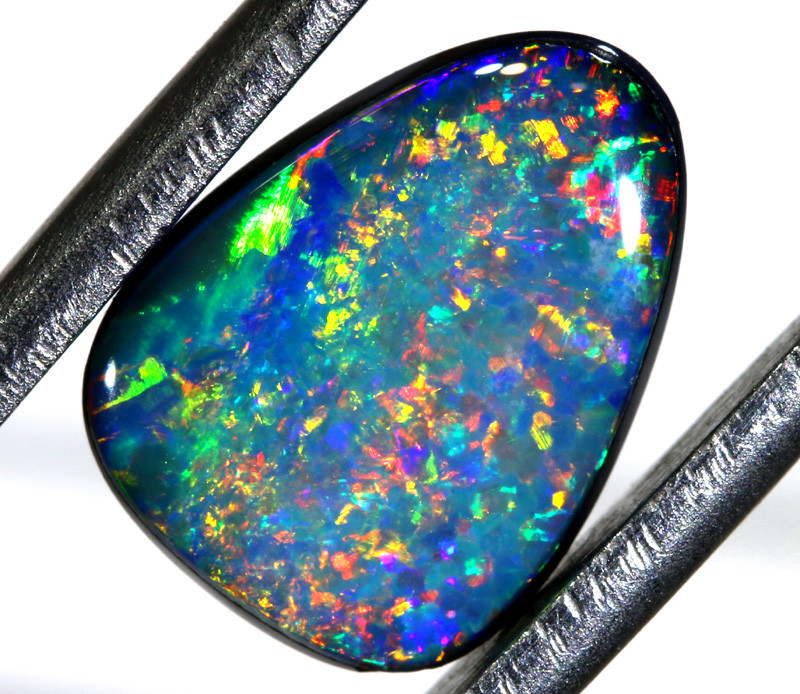
Dɛn ne Common Opal?
Opal a wɔtaa de di dwuma, anaa “potch, ” ne opal ahorow a ɛdɔɔso sen biara wɔ wiase nyinaa. Aboɔden abo no wɔ kɔla ahorow pii na opal ahorow dodow no ara hwe ase wɔ “opal a wɔtaa de di dwuma” nkatanim no ase. Wobɛyɛ dɛn ahu opal a wɔtaa de di dwuma? Sɛ ɔbo no nkyerɛ play-of-color a, ɛnde ɛyɛ good ol’ fashioned common opal.
Opal a wɔtaa de di dwuma no su foforo a wɔde wɔn nsa hyɛ ase ne opalescence. Opalescence yɛ aniwa mu tumi a ɛkyerɛkyerɛ opal a wɔtaa de di dwuma no mu hyerɛn a ɛte sɛ nufusu mu. Bere a sɛnea wɔde kɔla di agoru no ma aboɔden abo bi ani da hann adi no, opalescence te sɛ hann a ɛyɛ kusuu a efi ɔbo no mu reba.
Ɛkame ayɛ sɛ opal a wɔtaa de di dwuma no tumi da kɔla biara adi, na nnipa pii ani gye ne kɔla a ɛyɛ pastel no ho. Mpɛn pii no, opal a wɔtaa de di dwuma no wɔ nipadua fitaa anaa bruu .
Dɛn ne opal kɔla a ɛho yɛ na sen biara? Opal nhwɛsode ahorow a wɔntaa nhu no wɔ nipadua mu kɔla kɔkɔɔ anaa tuntum.
Nipadua nne tuntum yɛ kɛse ma opal su foforo a ɛyɛ anigye a wɔda no adi: fluorescence.
So woapaapae glow stick mu pɛn? Saa hann a ɛyɛ ahabammono a wuhu wɔ ɛno akyi no fi fluorescence. Opal tumi da fluorescence adi mmerɛw anaasɛ ɛyɛ den, mpo wɔ kɔla ahabammono koro no ara a ɛte sɛ glow stick mu. Opal nso betumi ayɛ hann a ɛyɛ kɔkɔɔ-ahabammono, bruu a ɛyɛ hann, ahabammono-brown, anaa fitaa.
Ɛda adi kɛse sɛ nea ɛde opal fluorescence ba ne uranium a ɛwɔ aboɔden abo no mu a ɛkyerɛ. Uranium pii betumi ama hann a ano yɛ den aba. Fluorescent opals bi a efi Nevada no wɔ uranium 0.12% wɔ ne mu duru mu!
Yenim baabi a opal fluorescence fi, nanso ne kɔla nso ɛ?

Dɛn na Ɛde Opal Kɔla Ba?
Opal a ɛtaa ba na ɛsom bo wɔ mmeae koro no ara: abotan mu tɔnn wɔ mmeae a wim tebea yɛ kusuu. Ebia ɛsɛ sɛ wɔn a wotu fam no tutu fam anammɔn 60 na ama wɔahu opal a ɛfata sɛ wɔtɔn. Dɛn nti na emu dɔ saa? Wiɛ, opal a ɛba no kɔ so wɔ mfe ɔpepem pii mu.
Nea edi kan no, nsu a ɛyɛ hyew kɔ fam. Bere a ɛsen kɔ asase mu no, nsu no boaboa silika kurukuruwa ano. Awiei koraa no, nsu a silica wom no kɔhyɛ kotoku mu wɔ ɔbotan no mu. Silica kurukuruwa no bom bere a nsu no yɛ hyew no, na ɛma opal a ɛyɛ kɔla ahorow no.
Ɛhe na opal kɔla ba? Ne nyinaa san kɔ silica kurukuruwa no so.
Silica kurukuruwa a ɛwɔ opal mu no yɛ silicon dioxide ahwehwɛ wɔ mfiridwuma mu. Sɛ kurukuruwa no kɛse bɛyɛ pɛ na wɔahyɛ no ma wɔ akuwakuw a wɔahyehyɛ no fɛfɛɛfɛ mu a, yehu kɔla a wɔde di agoru. So abɔde nyɛ nwonwa? Kurukuruwa biara kɛse na ɛkyerɛ hann kɔla ko a saa beae no da no adi.
Sɛ woadi akyi a, ebia wubehu sɛ opal a ɛsom bo nkutoo na ɛwɔ kurukuruwa a ɛyɛ den. Sɛ saa a, A+ ma wo!
Common opal silica kurukuruwa no nyɛ nea wɔahyehyɛ no yiye na ɛsono ne kɛse kɛse. Enti, opal a wɔtaa de di dwuma no ntumi nna hann a ɛsom bo a opal a ɛsom bo tumi no adi. Mmom no, opal a wɔtaa de di dwuma no tumi da kɔla kakraa bi pɛ adi, a ne kɛse ne kwan a ɛda ne kurukuruwa no ntam na ɛkyerɛ.
Wɔ asɛmti a ɛfa akyirikyiri ho no, opal a wɔbɔ abɔmmɔ no te sɛn? Afei, yɛbɛkyekyɛ opal hotspots nyinaa mu wɔ wiase nyinaa sɛnea ɛbɛyɛ a wubetumi ayɛ wo opal odyssey a edi hɔ no ho nhyehyɛe!
Opal Kɔla Ahorow Sɛnea Mpɔtam Hɔ
Ɛwom sɛ wobetumi ahu opal wɔ abotan ne mmeae ahorow de, nanso mmeae pɔtee bi ma opal kɔla ahorow ba. Wonim mmeae bi sɛ ɛwɔ opal ahorow.
Wonim kurow biako a wɔfrɛ no Coober Pedy a ɛwɔ South Australia sɛ “ wiase no opal ahenkurow .” Australia agye din kɛse wɔ ne opals ho, opal yɛ ɔman no ɔman aboɔden abo!
Australia
Australia de opal a ɛdɔɔso sen biara wɔ wiase no bi hoahoa ne ho. Nokwarem no, anyɛ yiye koraa no, wiase no mu opals 90% fi Australia!
Ɔman biara a wɔyɛ opal wɔ Australia no wɔ opal kɔla soronko bi.
Wɔ Australia Atɔe fam mfuw mu no, opal a ɛyɛ pink abu so. “pink opal” yɛ aguadi din a wɔde frɛ Mookaite a wɔde opal abata ho ankasa. Nanso, opaline Mookaite betumi ada nsusuwii ahorow adi wɔ cream, kɔkɔɔ, ne kɔkɔɔ ahorow mu.
Ɔbo foforo a wɔde opaline ayɛ ne boulder opal .
Wohu boulder opal wɔ Queensland, na ɛyɛ opal ne dade abo a wɔaka abom. Abotan opal biara wɔ kɔla ne nsusuwso soronko. Mpɛn pii no, boulder opal yɛ bruu a ɛyɛ kɔkɔɔ, bruu, anaa ahabammono a ɛhyerɛn apete.
Opal kɔla tuntum a ɛyɛ soronko no ne New South Wales aduan titiriw.
Ɛyɛ den yiye sɛ wubenya opal tuntum . Ebia nnipa kakraa bi a wɔwɔ anigye a wobetumi anya opal tuntum no bɛyera wɔ ne hyerɛn ne ne kɔla ahorow a ɛyɛ nwonwa no mu.
Nea etwa to no, South Australia yɛ wɔn a wɔyɛ opal a emu yɛ hare ho adwuma titiriw. Mpɛn pii no, opal a emu yɛ hare yɛ fitaa anaa krim, na ɛma ɔbo no din “opal fitaa” anaa “opal a ɛte sɛ nufusu.”
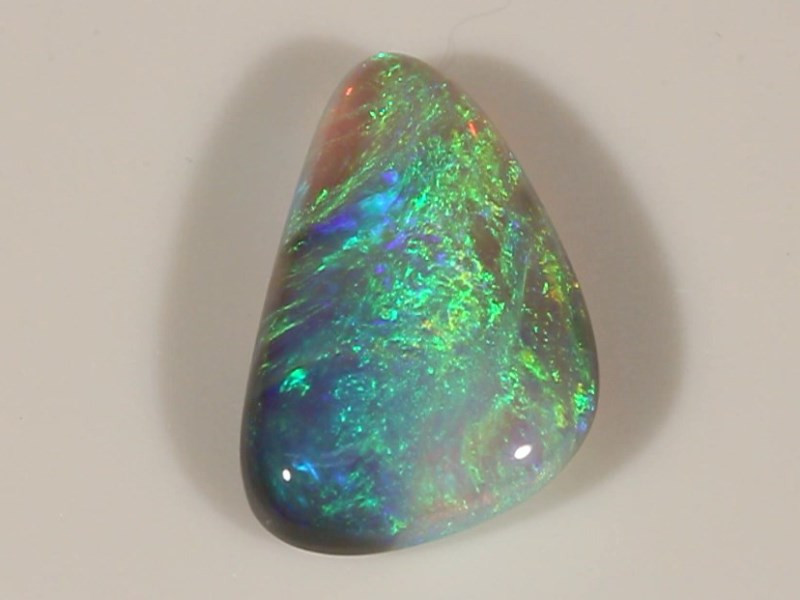 Australiafo Abibifo Opal
Australiafo Abibifo Opal
Afrika
Ethiopia ne Kenya anya nkɔso kɛse wɔ opal gua so.
Australia yɛ opal hene, nanso Ethiopia asi akan wɔ abotiri no ho .
Ethiopiafo opal dodow no ara yɛ opal fitaa ne cream a ɛsom bo. Wɔ nnansa yi mfe mu no, opal kɔla tuntum a wɔn kɔn dɔ no ada adi wɔ Ethiopia nneɛma a wɔde asie nso mu.
Ethiopiafo Welo opal yɛ mpɔtam hɔ ahorow foforo a ɛyɛ nwonwa. Wɔde Wollo Mantam no din too Welo opal so, na ɛyɛ ogya opal a ɛsom bo a ne nipadua kɔla yɛ kɔkɔɔ, borɔdɔma, ne kɔkɔɔ. Welo opals betumi ada kɔla a ɛyɛ ahabammono anaa kɔkɔɔ a ɛyɛ hyew adi.
Kenya di dwuma titiriw wɔ opal abakɔsɛm mu sɛ beae a opal a akyɛ sen biara a wɔahu pɛn no wɔ. Wɔ nnɛyi mmere yi mu no, opal a wɔtaa de di dwuma ne opal ahorow a ɛdɔɔso sen biara wɔ Kenya. Kɔla bɛn na wɔyɛ? Kenya opal kɔla ahorow no yɛ ngodua ahabammono a ɛyɛ fɛ.
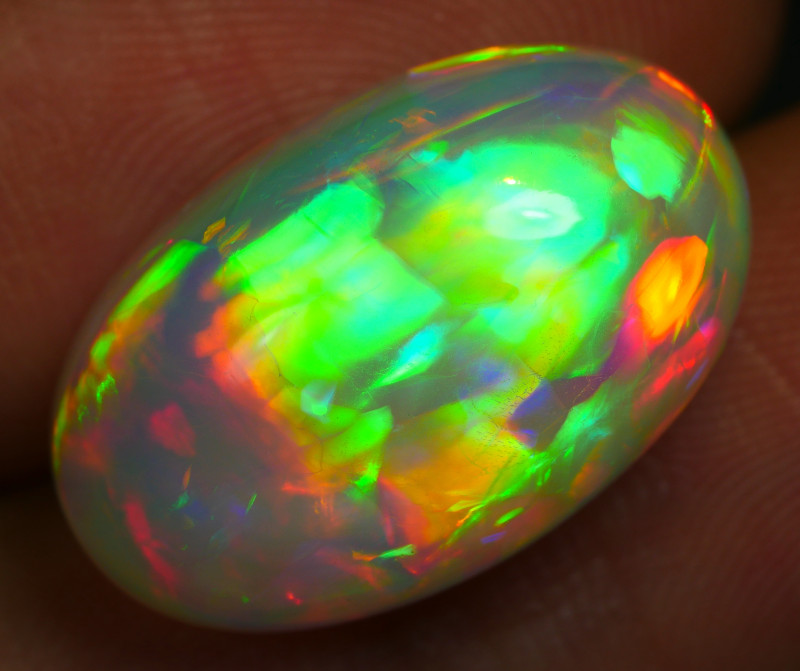 Etiopiafo Welo Opal na ɔkyerɛwee
Etiopiafo Welo Opal na ɔkyerɛwee
Amerika Kesee Fam
Wɔ Amerika Kesee Fam no, Peru ne Brazil ne aman atitiriw a wɔde opal ma wɔ asasepɔn no so.
Sɛ woyɛ obi a wopɛ pastel kɔla ahorow no a, w’ani begye Peru opal ahorow a wɔaboaboa ano no ho. Peru opal ahorow no wɔ pastel ahorow a ɛyɛ mmerɛw, titiriw pink, bruu, ne ahabammono.
Brazilfo opal yɛ soronko wɔ sɛnea ɛtra hɔ kyɛ na ɛhyerɛn no mu. Brazil ahwehwɛ opal no da kɔla a wɔde di agoru adi wɔ ahintasɛm pastel nne ahorow mu. Nsu a ɛba fam a ɛwɔ saa aboɔden abo yi mu no ma ɛtra hɔ kyɛ yiye, enti agudeyɛfo betumi de opal kɔla ahorow a eye sen biara aba denam akwan horow a wɔfa so yɛ afã horow so.
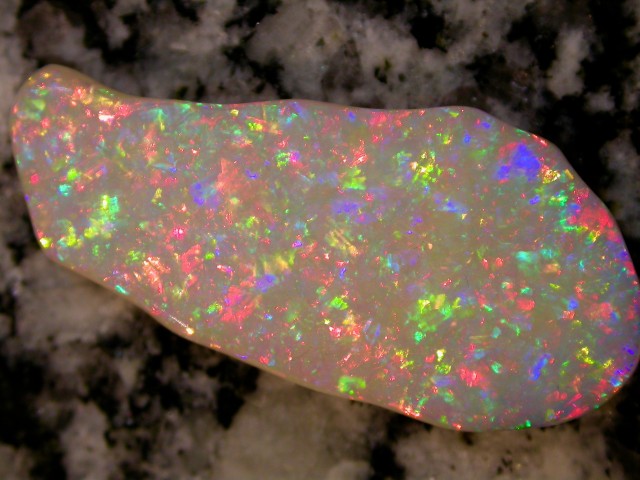 Brazilfo Opal a wɔfrɛ no Opal
Brazilfo Opal a wɔfrɛ no Opal
Mexico
Mexico de opal kɔla soronko abien hoahoa ne ho: Mexico ogya opal ne Morado opal.
Bere a opal pii yɛ nea ɛyɛ hann kosi nea ɛnyɛ hann no, Mexicofo opal kɔla ahorow da ne soro a ɛyɛ mmerɛw kosi nea ɛyɛ hann adi.
Ebia ɛnyɛ nwonwa sɛ Mexicofo ogya opal kɔla te sɛ ogya. Aboɔden abo no betumi ayɛ kɔkɔɔ, fitaa, borɔdɔma, anaa kɔkɔɔ. Te sɛ ogyaframa a ɛredɛw no, nhwɛsode a eye sen biara no wɔ kɔla kɔkɔɔ-akutu a ɛyɛ ma.
Morado opal yɛ opal kɔla ahorow a ɛyɛ kɔkɔɔ. Morado kyerɛ “kɔkɔɔ” wɔ Spania kasa mu, na ɛno nti na wɔtoo no din no. Mpɛn pii no, saa opal ahorow yi yɛ nea ɛnyɛ hann a ɛwɔ lavender a ɛte sɛ nufusu ne violet kɔla.
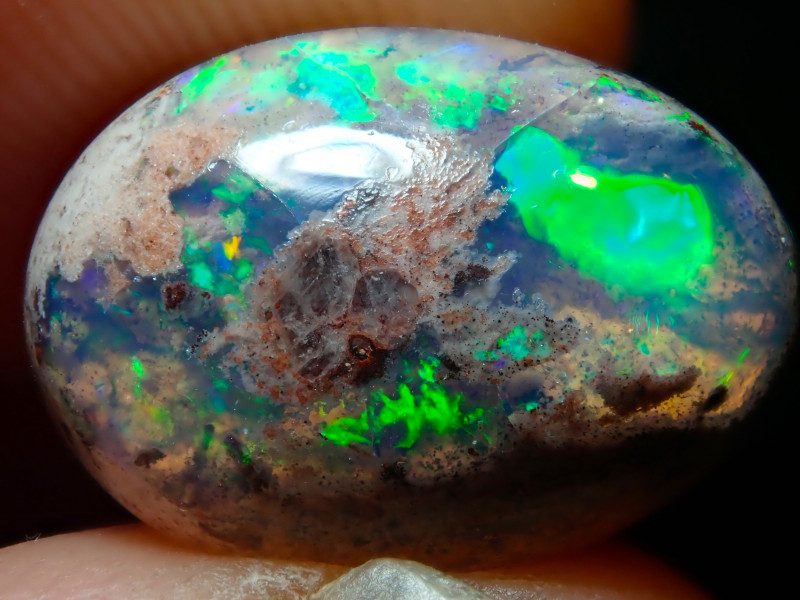 Mexicofo Ogya Opal
Mexicofo Ogya Opal
United States
Amerikafo opal a wotu no atrɛw wɔ ɔman no mu nyinaa, nanso aman abien a ɛda nsow a wɔyɛ opal ne Oregon ne Nevada.
Oregon. Oregon wɔ opal a wotu a ɛho hia abien: biako wɔ beae bi a wɔato din Opal Butte ma ɛfata na biako wɔ Lake County. Oregon opal dodow no ara yɛ pink, kɔkɔɔ, ne bruu.
Ogya bepɔw mu nsõ a ɛtɔ wɔ ɔman no mu no ma tebea kɛse ba ma nnua a wɔde opalized ayɛ no betumi aba. Nnua a wɔde opalized ayɛ no yɛ nnua a wɔayɛ no abo a opal wom sen sɛ wɔbɛma chalcedony a abu so kɛse no bɛhyɛ mu.
Nnua a wɔde opalized ayɛ no ba bere a nsõ a ɛtɔ ma kwae a ɛbɔ ho ban ba no, na ɛma nsõ no mu silica a apete no tumi kɔ fam no. Efi hɔ no, asase ase nsu fibea ahorow betumi aboaboa silica no ano na afi ase ayɛ opal a wɔtaa yɛ no.
Nevada na ɛwɔ hɔ. Ɛhɔfo a wɔwɔ Virgin Valley, Nevada, ka sɛ opal fii ase yɛɛ wɔ hɔ mfe ɔpepem pii a atwam ni. Ebia nnompe a wɔde opal ayɛ no bɛma saa nsusuwii yi mu duru kakra, nanso obiara ntumi nsi pi bere a opal no hyehyɛe wɔ nnompe no so no.
Ɛmfa ho nea ɛbɛba biara no, Virgin Valley opal ahorow fi dɔte mpa a ɛyɛ nsu mu ba a ɛwɔ kɔla ahorow a ɛyɛ nwonwa. Nevada opals no bi ne black opal ne black opal a ɛsom bo, sɛ yɛbɛhyɛ aseɛ a. Opal afoforo a wotu ne opal fitaa ne kɔkɔɔ, ne opal a moss anaa dendrite ka ho.
Uranium dodow a ɛkɔ soro wɔ mpɔtam hɔ no ma opal pii nya fluorescence kɛse. Wɔ kanea a ɛyɛ ultraviolet (anaa kanea tuntum) ase no, saa opal ahorow yi hyerɛn a ɛyɛ ahabammono a anyinam ahoɔden wom.
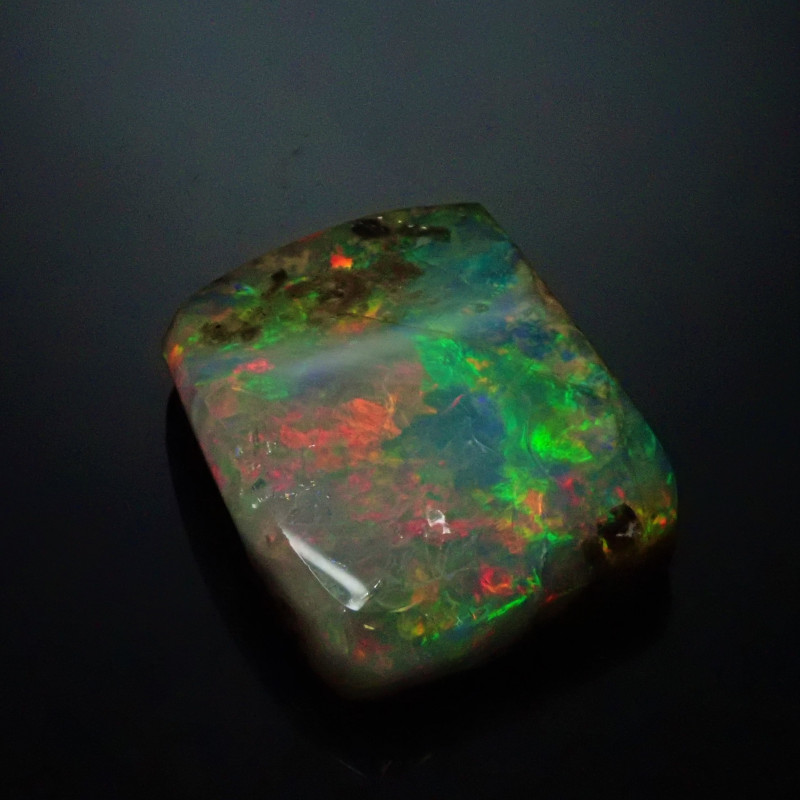 Virgin Valley Amerikafo Opal a wɔfrɛ no Opal
Virgin Valley Amerikafo Opal a wɔfrɛ no Opal
Esiane sɛ opal kɔla ahorow a wubetumi apaw nyinaa wɔ hɔ nti, ebia wubesusuw ho sɛ: Dɛn ne opal ahorow a eye sen biara a wubetumi atɔ?
Sɛnea Kɔla Ka Opal Botae
Opal bo a wobɛkyerɛ no nyɛ adeyɛ a ɛyɛ mmerɛw. Nneɛma pii ka opal bo a ɛsom nyinaa, efi baabi a wotu no kosi sɛnea ɛyɛ, ne nokwarem no, ne kɔla soronko no.
Nanso sɛ yɛbɛka no ɔkwan biara so a, opal a ɛsom bo sen biara no ne ahorow a wɔntaa nhu na opal a ne bo nyɛ den no na abu so sen biara.
Enti, kɔla bɛn na opal som bo kɛse?
Opal tuntum ne opal ahorow a wɔntaa nhu, na ɛyɛ den mpo sɛ wobenya opal tuntum a ɛsom bo. Nanso, opal kɔla a wɔtaa de di dwuma a ɛsom bo kɛse ne opal kɔkɔɔ a wɔntaa nhu no. Opal a ɛyɛ borɔdɔma, ahabammono, bruu, ne kɔkɔɔ na edi hɔ wɔ bo a ɛsom ho.
Sɛ wopɛ sɛ wuhu a, opal a ne bo yɛ den sen biara wɔ wiase ne The Virgin Rainbow (mfonini a ɛwɔ ase hɔ no). Wohuu The Virgin Rainbow wɔ afe 2003 mu, na ne bo boro dɔla ɔpepem biako. Mprempren wɔde nhwɛsode a ɛyɛ nwonwa no rekyerɛ wɔ South Australia Tete Nneɛma Akorae.
 Hwehwɛ Opal Rainbow no mu!
Hwehwɛ Opal Rainbow no mu!
Sɛ woasiesie wo ho sɛ wobɛhyehyɛ bag na woayɛ opal akwantu ho nhyehyɛe a, yɛmfa asodi no nto wo so! Opal yɛ aboɔden abo a ɛyɛ soronko, nanso opal biara yɛ soronko!
Bere a nimdeɛ yi nyinaa wɔ wo bɛlt ase no, woasiesie wo ho sɛ wobɛma w’ani agye. Dɛn nti na wontow “Dɛn ne kɔla a w’ani gye ho paa?” line for “Dɛn ne opal kɔla a w’ani gye ho paa?”
Mma ɛnhaw wo, opal kɔla pii wɔ hɔ a wubetumi akɔ akɔkyinkyin!
So woapaw nea w’ani gye ho? Hwehwɛ opal kɔla a ɛyɛ pɛpɛɛpɛ ma wo!
搜尋Opal Encyclopedia
相關拍賣
相關文章
Boulder Opal yɛ opal a ne bo nyɛ den a ɛsom bo wɔ gua so no mu biako. Sua pii fa opal soronko yi ho na hwehwɛ abo a ɛyɛ fɛ a yɛwɔ a yɛtɔn no mu.
29th May 2019
Esiane sɛ Wayne ne Estella Sedawie ani gye opals ho nti, wɔde Opal Plus sii hɔ bɛboro mfe 14 a atwam ni na wɔahu sɛ intanɛt yɛ adwinnade a ɛsom bo. Ɛhɔ na adwumakuw no amanaman ntam nkitahodi dodow no ara kɔ so.
17th Oct 2018
最新的文章
Black opals ne opal ahorow a wɔhwehwɛ sen biara, na ne nnyinaso a emu dɔ ma nyankontɔn a ɛyɛ hann wɔ soro. Hu sɛnea wɔde opal tuntum di dwuma, ne su, abakɔsɛm, ne bo a ɛsom!
7th Dec 2025
Hu sɛnea wɔde opal ahorow hyehyɛ mu ne nneɛma a ɛka ne bo. Efi kɔla ne hann so kosi nea wɔatwa ne nea efi mu ba so, sua sɛnea wɔbu opal ahorow biara bo - a nhwɛso ne bo ahorow.
19th Jul 2023
Bra akwantuo mu na sua opals ayaresa tumi ho asɛm firi yɛn ahɔhoɔ kyerɛwfoɔ Vivien Schapera a ɔfiri Crystal Healing Techniques hɔ!
20th May 2023
文章類別
All there is to know about Opals including Black Opals, Ethiopian Opals & Boulder Opal
14文章
Check out our fascinating information and articles on all things amazing in the Opal world
41文章








